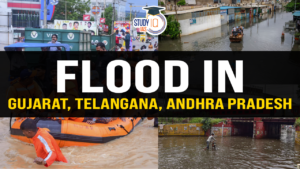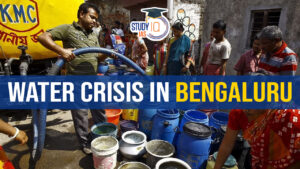Table of Contents
Context: The Monsoon 2025 floods across J&K, Himachal Pradesh, Punjab, and Uttarakhand exposed the ecological fragility of India’s mountain states and underscored the urgent need for a future-ready disaster management framework in the Himalayas.
Disaster Management in Himalayas: Technology in Action
- Drones: Used extensively for damage assessment, guidance of relief teams, and search & rescue.
- Satellite Communication & OneWeb links: Enabled coordination in areas where mobile towers collapsed.
- Doppler Radars & Nowcasting by IMD: Gave short-term forecasts for localised heavy rainfall.
- Temporary Incident Command Posts (ICPs): Allowed real-time coordination across agencies.
- GIS-based mapping: Supported route planning and resource allocation.
Scope for Expansion
- GSI must expand landslide mapping based on soil soaking and slope gradients.
- NRSC should monitor glacial lakes and debris flows 24×7.
- Predictive surveillance: Drones to continuously monitor vulnerable slopes, rivers, and glaciers.
- AI models: Integrating hydro-meteorological data for early prediction of flash floods and cloudbursts.
- Urban resilience: Adoption of local models such as the Gorakhpur Model of flood control.
Challenges Highlighted in the Himalayas
- Awareness Deficit: Despite lakhs of SMS alerts and the Sachet app, many citizens were unsure how to respond.
- Pilgrimage Vulnerability: Yatras like Machail, Manimahesh, and Gangotri continued even under red alerts, straining response capacity.
- Unchecked Development: Construction in riverbeds, slope destabilisation, and disregard for building codes. Illegal mining weakened embankments.
- Citizen Preparedness Gaps: Lack of community drills, minimal knowledge of evacuation routes or nearest shelters.
- Technology Gaps: Doppler radar network remains sparse across valleys; early warning systems are not yet localised.
- Response-Centric Approach: Focus remains on post-disaster action; prevention and resilience are still under-emphasised.
- Institutional Weaknesses: DDMAs often lack technical expertise and integration with civil society.
Way Forward
Community-Centric Preparedness:
- Deepen the Aapda Mitra Programme into schools, panchayats, and RWAs.
- Treat mock drills as essential training, not token exercises.
- Citizen handbooks with evacuation protocols.
Scaling Technology
- A dense network of Doppler radars across valleys.
- GIS-based risk mapping of slopes, rivers, and villages.
- Drone-based predictive surveillance, coupled with AI forecasting models.
- NRSC to monitor glacial lakes and debris flows
Stronger Infrastructure & “Build Back Better”
- Roads rebuilt with slope stabilisation techniques.
- Enforce no-build zones along rivers and strict adherence to seismic building codes.
- Reinforce river embankments and curb illegal sand mining.
Institutional Strengthening
- Build a technically oriented disaster management cadre.
- Empower DDMAs to integrate civil society and local knowledge.
- Mandate disaster awareness events in schools and workplaces.
Balancing Development & Ecology
- Adopt sustainable construction practices.
- Promote eco-tourism and regulate pilgrim footfall with seasonal restrictions.


 Floods In India, Causes, Flood Prone Are...
Floods In India, Causes, Flood Prone Are...
 Wayanad Landslides, Causes, Impacts and ...
Wayanad Landslides, Causes, Impacts and ...
 Water Crisis in Bengaluru, Causes, Impac...
Water Crisis in Bengaluru, Causes, Impac...

























